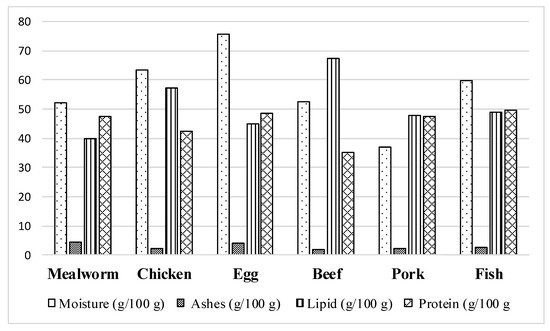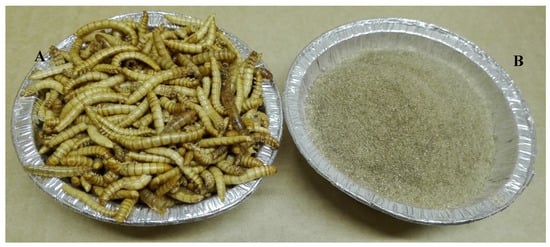
| Version | Summary | Created by | Modification | Content Size | Created at | Operation |
|---|---|---|---|---|---|---|
| 1 | Karin Wendin | + 2214 word(s) | 2214 | 2021-06-25 09:49:21 | | | |
| 2 | Peter Tang | Meta information modification | 2214 | 2021-07-05 11:48:45 | | |
Video Upload Options
Insects, especially mealworms, have a similar or higher nutritional value than many conventional food sources. For example, the protein content of mealworm larvae is reported to be almost 50% of dry weight, while the fat content is about 30% of larval dry weight. Mealworms can be cooked by different methods, such as hot air drying, oven broiling, roasting, pan frying, deep frying, boiling, steaming, and microwaving. Oven broiling in particular gives a desirable aroma of steamed corn for consumers.
1. Introduction

2. Nutritional Value of Insects

3. Sensory Aspects
|
Insect (English) |
Insect (Latin Name) |
Sensory Description |
|---|---|---|
|
Mealworm |
Tenebrio molitor |
Nutty, umami. Intense aroma of cereal, nuttiness, and wood, a less pronounced aroma of broth. Intense flavor of nut, cereal, and umami and slightly less intense flavor of vegetables and Maillard reaction products. Brittle texture. |
|
Alphitobiusdiaperinus |
Distinct aroma of cereal and nuttiness, notes of broth. Intense flavor of umami, nuttiness, and cereal. Less intense notes of vegetables and Maillard reaction products. Crumbly texture. |
|
|
Cricket |
Sub-order Ensifera Achetadomesticus |
Umami, popcorn, chicken, mild, creamy. Pronounced aroma of broth, nuttiness, and cereal, with notes of wood. Intense flavor of umami and vegetables. Apparent note of nuttiness and, a bit less pronounced, cereal and Maillard reaction products. Crumbly texture. |
|
Grasshopper |
Sub-order Caelifera Locustamigratoria |
Shrimp. An intense aroma of cereal, wood, and nuttiness. Notes of broth and fruit. The flavor has an intense umami and vegetable character, combined with nuttiness and cereal, and notes of Maillard reaction products and relatively low saltiness. Crusty, hard, and coarse texture. |
|
Red wood ant |
Formica rufo |
Intense sourness, lemon |
|
Black ant |
Polyrhachisvicina |
A distinct aroma of soy sauce and broth, emergent note of berries and less so fruit. Intense sour flavor with a pronounced Maillard reaction product character. Notes of umami, nuttiness, and bitterness. Crusty, coarse, grainy, and hard texture. |
|
Jet ant |
Lasiusfuliginosus |
Mild acidity, kaffir lime |
|
Termite |
MacrotermesbellicosusMacrotermessubhyalinusNasutitermestriodiae |
Crunchy, nutty, fatty, savory. A pronounced aroma of nuttiness and broth, with notes of cereal, wood, and soy sauce. Intense flavor of Maillard reaction products, salt, and nuttiness. Flavor notes of umami and cereal, and a relatively mild vegetable flavor. Texture characterized by coarse grain and brittleness. |
4. Insect Foods and Its Acceptance

|
Insect |
Commonly Considered as |
Where EATEN Locally—Examples |
Method of Preparation |
Part of Insect Common LY Eaten |
|---|---|---|---|---|
|
Mealworm |
Cereal grain pest [35] |
Africa, Asia, the Americas, Australia [36] |
Stir-frying, grilling [37] |
Whole larvae [38] |
|
Cricket |
Disgusting [39] |
Asia (Thailand), Africa (Zimbabwe) [40] |
Deep-frying [40] |
Whole insects [40] |
|
Grasshopper |
Agricultural pest [41] |
Africa (Angola), Asia (Japan), Latin America (Mexico) [40] |
Frying [42] |
Whole adult insect after removing wings [43] (wings and legs are removed) |
|
Termite |
Wood environment pest [44] |
Sub-Saharan Africa (Uganda) [38] |
Can be eaten raw [38] |
Whole insect [45] |
References
- United Nations. 2017. Available online: (accessed on 12 March 2019).
- Veldkamp, T.; Van Duinkerken, G.; Van Huis, A.; Lakemond, C.M.M.; Ottevanger, E.; Bosch, G.; Van Boekel, T. Insects as A Sustainable Feed Ingredient in Pig and Poultry Diets: A Feasibility Study. Insecten als duurzame diervoedergrondstof in varkens-en pluimveevoeders: Een haalbaarheidsstudie 2012, (No. 638); Wageningen UR Livestock Research: Wageningen, The Netherlands, 2012.
- Aiking, H. Future protein supply. Trends Food Sci. Technol. 2011, 22, 112–120.
- Nasseri, A.T.; Rasoul-Amini, S.; Morowvat, M.H.; Ghasemi, Y. Single cell protein: Production and process. Am. J. Food Technol. 2011, 6, 103–116.
- Nijdam, D.; Rood, T.; Westhoek, H. The price of protein: Review of land use and carbon footprints from life cycle assessments of animal food products and their substitutes. Food Policy 2012, 37, 760–770.
- Daylan, A.; Sosa, T.; Gent, U.; Fogliano, V. Potential of insect-derived ingredients for food applications. In Insect Physiology and Ecology; IntechOpen: London, UK, 2017; pp. 215–231.
- Kouřimská, L.; Adámková, A. Review article: Nutritional and sensory quality of edible insects. NFS J. 2016, 4, 22–26.
- Van Huis, A. Potential of insects as food and feed in assuring food security. Annu. Rev. Entomol. 2013, 58, 563–583.
- Jongema, Y. List of Edible Insects of the World. 2012. Available online: (accessed on 12 March 2019).
- Lesnik, J.J. Termites in the hominin diet: A meta-analysis of termite genera, species and castes as a dietary supplement for South African robust australopithecines. J. Hum. Evol. 2014, 71, 94–104.
- Sponheimer, M.; de Ruiter, D.; Lee-Thorp, J.; Späth, A. Sr/Ca and early species and castes as a dietary supplement for South African robust australopithecines. J. Hum. Evol. 2005, 71, 94–104.
- Payne, C.L.R.; Scarborough, P.; Rayner, M.; Nonaka, K. Are edible insects more or less ‘healthy’ than commonly consumed meats—A comparison using two nutrient profiling models developed to combat over- and undernutrition. Eur. J. Clin. Nutr. 2015, 70, 285–291.
- Zhao, X.; Vázquez-Gutiérrez, J.L.; Johansson, D.P.; Landberg, R.; Langton, M. Yellow mealworm protein for food purposes. Extraction and functional properties. PLoS ONE 2016, 11, e0147791.
- Ekpo, K.E. Effect of processing on the protein quality of four popular insects consumed in Southern Nigeria. Arch. Appl. Sci. Res. 2011, 3, 307–326.
- Bukkens, S.G.F. Insects in the human diet: Nutritional aspects. In Ecological Implications of Minilivestock (Role of Rodents, Frogs, Snails, and Insects for Sustainable Development); Paoletti, M.G., Ed.; New Hampshire, Science Publishers: New Ipswich, NH, USA, 2005; pp. 545–577.
- Ramos-ElorduyBlasquez, J.; Pino Moreno, J.M.; Martinez Camacho, V.H. Could grasshoppers be a nutritive meal. Food Nutr. Sci. 2012, 3, 164–175.
- Ramos-Elorduy, J.; Moreno, J.M.; Prado, E.E.; Perez, M.A.; Otero, J.L.; De Guevara, O.L. Nutritional value of edible insects from the State of Oaxaca, Mexico. J. Food Compos. Anal. 1997, 10, 142–157.
- Rumpold, B.A.; Schlüter, O.K. Nutritional composition and safety aspects of edible insects. Mol. Nutr. Food Res. 2013, 57, 802–823.
- Verkerk, M.C.; Tramper, J.; Van Trijp, J.C.M.; Martens, D.E. Insect cells for human food. Biotechnol. Adv. 2007, 25, 198–202.
- Zielińska, E.; Baraniak, B.; Karaś, M.; Rybczyńska, K.; Jakubczyk, A. Selected species of edible insects as a source of nutrient composition. Food Res. Int. 2015, 77, 460–466.
- Azzollini, D.; Derossi, A.; Fogliano, V.; Lakemond, C.M.M.; Severini, C. Effects of formulation and process conditions on microstructure, texture and digestibility of extruded insect-riched snacks. Innov. Food Sci. Emerg. Technol. 2018, 45, 344–353.
- Kamler, E. Early Life History of Fish: An Energetics Approach; Springer Science & Business Media: Berlin, Germany, 2012; Volume 4, p. 72.
- Fitzpatrick, J.J.; Iqbal, T.; Delaney, C.; Twomey, T.; Keogh, M.K. Effect of powder properties and storage conditions on the flowability of milk powders with different fat contents. J. Food Eng. 2004, 64, 435–444.
- Alves, A.V.; Sanjinez-Argandoña, E.J.; Linzmeier, A.M.; Cardoso, C.A.L.; Macedo, M.L.R. Food value of mealworm grown on Acrocomiaaculeata pulp flour. PLoS ONE 2016, 11, e0151275.
- Astrup Pedersen, J. Disgusting or Delicious—Utilization of Bee Larvae as Ingredient and Consumer Acceptance of the Resulting Food. Ph.D. Thesis, Copenhagen University, Copenhagen, Denmark, 2014.
- Wendin, K.; Norman, C.; Forsberg, S.; Langton, M.; Davidsson, F.; Josell, Å.; Prim, M.; Berg, J. Eat’em or not? Insects as a culinary delicacy. In Proceedings of the 10th International Conference on Culinary Arts and Sciences, Copenhagen, Denmark, 6–7 July 2017; Mikkelsen, B., Ofei, K.T., Olsen Tvedebrink, T.D., Quinto Romano, A., Sudzina, F., Eds.; Aalborg University: Copenhagen, Denmark, 2017; pp. 100–106, ISBN 978-87-970462-0-3.
- Evans, J.; Flore, R.; Frøst, M.B. On Eating Insects Essays, Stories and Recipes; Phaidon: London, UK, 2017.
- Van Huis, A.; Van Gurp, H.; Dicke, M. The Insect Cookbook—Food for a Sustainable Planet; Colombia University Press: New York, NY, USA, 2014.
- Albrektsson, O. It Really Bugs Me…: En Deskriptiv Sensorisk Analys av Sju Ätbara Insekter. Bachelor’s Thesis, Örebro University, Örebro, Sweden, 2017.
- Rahman, M.S. Handbook of Food Preservation, 2nd ed.; CRC Press: Boca Raton, FL, USA, 2007.
- Prim, M. Tenebrio Molitor—Smaklig, Hälsosam och Hållbar; SP Report 2016; Vinnova: Stockholm, Sweden, 2016; p. 87. (In Swedish)
- Sheppard, B.; Frazer, P. Comparing social and intellectual appeals to reduce disgust of eating crickets. Stud. Arts Humanit. 2015, 1, 4–23.
- Megido, R.C.; Gierts, C.; Blecker, C.; Brostaux, Y.; Haubruge, É.; Alabi, T.; Francis, F. Consumer acceptance of insect-based alternative meat products in Western countries. Food Qual. Prefer. 2016, 52, 237–243.
- Choi, Y.S.; Kim, T.K.; Choi, H.D.; Park, J.D.; Sung, J.M.; Jeon, K.H.; Paik, H.D.; Kim, Y.B. Optimization of replacing pork meat with yellow worm (Tenebrio molitor L.) for Frankfurters. Korean J. Food Sci. Anim. Resour. 2017, 37, 617–625.
- Marriott, N.G.; Schilling, M.W.; Gravani, R.B. Low-moisture food manufacturing and storage sanitation. In Principles of Food Sanitation; Springer: Cham, Switzerland, 2018; pp. 279–293.
- Siemianowska, E.; Kosewska, A.; Aljewicz, M.; Skibniewska, K.A.; Polak-Juszczak, L.; Jarocki, A.; Jędras, M. Larvae of mealworm (Tenebrio molitor L.) as European novel food. Agric. Sci. 2013, 4, 287–291.
- Rumpold, B.A.; Fröhling, A.; Reineke, K.; Knorr, D.; Boguslawski, S.; Ehlbeck, J.; Schlüter, O. Comparison of volumetric and surface decontamination techniques for innovative processing of mealworm larvae (Tenebrio molitor). Innov. Food Sci. Emerg. Technol. 2014, 26, 232–241.
- Srivastava, S.K.; Babu, N.; Pandey, H. Traditional insect bioprospecting–As human food and medicine. Indian J. Tradit. Knwl. 2009, 8, 485–494.
- Gmuer, A.; NuessliGuth, J.; Hartmann, C.; Siegrist, M. Effects of the degree of processing of insect ingredients in snacks on expected emotional experiences and willingness to eat. Food Qual. Prefer. 2016, 54, 117–127.
- Chakravarthy, A.K.; Jayasimha, G.T.; Rachana, R.R.; Rohini, G. Insects as Human Food. In Economic and Ecological Significance of Arthropods in Diversified Ecosystems; Springer: Singapore, 2016; pp. 133–146.
- Toure, M.; Seye, F.; Fall, A.; Ndione, R.D.; Badiane, T.S.; Ndiaye, M. Efficacy of Metarhizium anisoplae (Metschnikoff, Sorokin) on the Senegalese grasshopper Oedaleus senegalensis (Krauss 1877) in its natural environment. J. Agric. Crop. 2018, 4, 1–7.
- Ribeiro, J.C.; Cunha, L.M.; Sousa-Pinto, B.; Fonseca, J. Allergic risks of consuming edible insects: A systematic review. Mol. Nutr. Food Res. 2018, 62, 1700030.
- Gardiner, A.J.; Gardiner, E.M. Edible insects, Part 1. Preparation of species from Mushumbi Pools, Zimbabwe. Afr. Entomol. 2003, 11, 125–127.
- Mahapatro, G.K.; Chatterjee, D. Integrated termite management in the context of indoor and outdoor pest situation. In Termites and Sustainable Management; Springer: Cham, Switzerland, 2018; pp. 119–135.
- Neoh, K.B. Termites and human society in Southeast Asia. Int. Assoc. Asian Stud. Newsl. 2013, 66, 30–31.
- Aguilar-Miranda, E.D.; López, M.G.; Escamilla-Santana, C.; Barba de la Rosa, A.P. Characteristics of maize flour tortilla supplemented with ground Tenebrio molitor larvae. J. Agric. Food Chem. 2002, 50, 192–195.
- Yen, A.L. Edible insects: Traditional knowledge or western phobia? Entomol. Res. 2009, 39, 289–298.
- Hamerman, E.J. Cooking and disgust sensitivity influence preference for attending insect-based food events. Appetite 2016, 96, 319–326.
- La Barbera, F.; Verneau, F.; Amato, M.; Grunert, K. Understanding Westerners’ disgust for the eating of insects: The role of food neophobia and implicit associations. Food Qual. Prefer. 2018, 64, 120–125.
- Verbeke, W. Profiling consumers who are ready to adopt insects as a meat substitute in a Western society. Food Qual. Prefer. 2015, 39, 147–155.
- Tan, H.S.G.; Verbaan, Y.T.; Stieger, M. How will better products improve the sensory-liking and willingness to buy insect-based foods? Food Res. Int. 2017, 92, 95–105.




